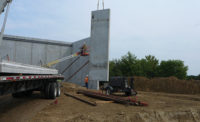Most Districts noted slight to moderate gains in consumer spending and a moderate increase in vehicle sales. Tourism showed signs of strength in several districts. A wide variety of business services expanded, and transportation traffic increased for producer, consumer, and trade goods.
Residential real estate and construction activity increased at a moderate to strong pace in all districts. Commercial real estate and construction activity grew at a modest to moderate pace in most districts. Overall bank lending increased since the previous report. Credit quality and deposits increased, while credit standards were largely unchanged.
Agricultural conditions remained mixed across districts, as weather patterns varied. Overall activity in the energy sector was flat, and mining was down.
Hiring increased at a measured pace in several districts, with some contacts noting difficulty finding qualified workers. Wage pressures remained contained overall, although several districts reported a modest or moderate rise for selected occupations. Districts reported level prices to mild price increases; some manufacturers raised prices and some increases for input prices
were noted.
Manufacturing
The manufacturing sector expanded in most districts. Activity increased in the Boston, Cleveland, Atlanta, Chicago, St. Louis, Minneapolis, Kansas City, Dallas, and San Francisco districts. Manufacturing contacts in the New York District reported steady business activity. In the Philadelphia district, manufacturers reported that orders and shipments have fallen somewhat, and in the Richmond district, manufacturing activity softened, although there were scattered reports of improvement.
Most firms in the Boston district are reasonably optimistic about the outlook, and many contacts in the Cleveland district believe that business conditions will continue to improve slowly during the second half of the year.
However, the near-term outlook has waned somewhat in the New York district.
Continuing a theme from the previous report, strength in residential construction was a boon to manufacturers who supplied that industry. Firms in the Philadelphia district supplying the home-building sector reported strong orders, and the Cleveland district noted that suppliers to residential construction were among those seeing the strongest activity, while the Richmond, St. Louis, Dallas, and San Francisco districts all reported increased demand for lumber or wood products.
Growth in the auto industry was noted by the Philadelphia, Cleveland, Atlanta, Chicago, and St. Louis districts, although the Chicago district reported that the auto industry grew at a more moderate pace.
Producers of inputs for the oil and gas industries saw growth in the Philadelphia, Cleveland, and Atlanta districts.
The food processing industry grew in the Philadelphia and Dallas districts.
Electrical equipment saw increased activity in the Boston and San Francisco districts but lower activity in the Philadelphia district.
Demand for fabricated metals expanded in the Philadelphia district, while specialty metal manufacturers in the Chicago district reported small increases in new orders, noting that their customers had become more cautious. Fabricated metals producers in the Dallas district reported that demand remained steady for both private and public projects.
The defense industry experienced weakening activity in the Cleveland district, and a producer of defense equipment in the Richmond district cited government sequestration and orders being canceled or delayed.
Steel production was mixed. Steel producers in the Cleveland district reported that shipping volume was stable but remains below levels seen early in the first quarter, and both the Cleveland and Chicago districts noted an increase in imports of steel. The St. Louis and San Francisco districts reported an increase in demand for steel. Lower demand for primary metals was noted in the Philadelphia and Dallas istricts.
Consumer spending and tourism
Most districts noted that consumer spending increased during the reporting period, ranging from slight to moderate gains.
Retail activity in the Boston, Philadelphia, and Dallas districts was characterized as modest or moderate, while the Cleveland, Atlanta, Chicago, St. Louis, Minneapolis, Kansas City, and San Francisco districts reported slight growth.
Retailers in the New York district reported that sales were tepid in April but picked up in May. Meanwhile, the Richmond district noted that sales were flat during the reporting period. The Boston, New York, Philadelphia, Cleveland, Richmond, Chicago, and Minneapolis districts reported that late winter weather slowed retail sales; the Chicago district noted that sales picked up once warmer weather arrived.
Demand for home furnishings and furniture was strong or picked up in the Boston, Cleveland, and Richmond districts; however, furniture sales slowed in the Chicago district. The Kansas City district reported that appliance purchases were particularly strong. Inventories were generally at desired levels in New York and Chicago.
The outlook for retail spending was positive in Kansas City and Dallas, while more cautious expectations were noted in Boston, Cleveland, and St. Louis.
Vehicle sales generally increased moderately across districts. New York, Richmond, and San Francisco reported that sales remained strong or at high levels. Meanwhile, Minneapolis reported modest growth in auto sales, and contacts in Kansas City reported that sales declined.
Used car sales increased in Chicago and St. Louis, while Richmond noted that the availability of used cars improved. Meanwhile, New York, Cleveland, and San Francisco reported a shortage of used cars or a decline in used car sales. Inventories increased in Cleveland and Kansas City, while inventories were lean in Philadelphia. More respondents to a St. Louis survey indicated that inventories were too high than too low. Philadelphia, Cleveland, St. Louis, Kansas City, and Dallas noted that the outlook for future sales was generally positive.
Tourism showed signs of strength in several districts. Boston reported increased tourism revenues but noted that attendance at museums and attractions was down, perhaps due to weather affecting leisure travel plans. New York noted that tourism activity was mixed but fairly robust since the previous report. Richmond reported that unseasonably cool weather negatively affected some resorts. Leisure and international travel continued to experience healthy demand in Atlanta. Extended winter weather boosted skiing in parts of Minneapolis. San Francisco reported that travel and tourism activity in Hawaii was robust, while activity in southern California declined a bit. Hotel occupancy and room rates were higher in Atlanta and Kansas City.
Advanced bookings and the overall outlook for summer travel were optimistic, but the San Francisco district indicated some concern that the flow of international visitors could taper off in coming months due to potential weakness in the global economy.



